 |
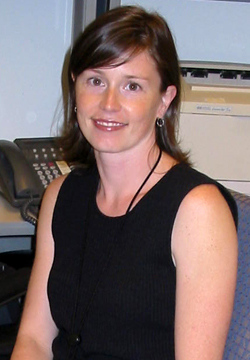
|
|
Angi M. Christensen, Ph.D., Forensic Science Technician, Evidence Analyst and Evidence Technician, Federal Bureau of Investigation Laboratory, Washington, D.C.
|
1. I chose this career because...
2. My typical workday involves...
3. What I like best/least about my work...
4. My career goals are...
5. When I'm not working, I like to...
6. It's never too late to change you career path...
|
|
1. I chose this career because...
|
Back to Top

|
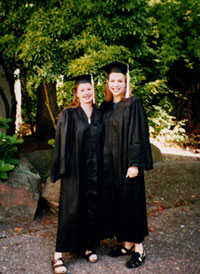
|
|
Angi Christensen is pictured (left) with a friend at her graduation from the University of Washington in Seattle, Washington.
|
I chose to become a forensic scientist because it is an interesting and challenging field that allows me to combine my passion for anthropology, love of puzzles, and compassion to help others. I was interested in science from a very young age. My parents and teachers nurtured this interest, and I never lost it. As a kid, I wanted to be an astronaut or an archaeologist. My favorite subjects in school were always science, sociology and math. My interest in science was so well known that in high school, I was voted Most likely to become a scientist.
Undergraduate School –Changing Majors
I began my undergraduate work as an engineering major. Some time during my second year, I took an anthropology class as an elective and immediately fell in love with it. I took another class the following semester to confirm my interest. Shortly thereafter, I changed my major. I discovered I had a particular interest in physical anthropology. Specifically, I found forensic anthropology fascinating. This field uses principles from physical anthropology to examine human skeletons to estimate the age, sex, ancestry and stature of the individual, as well as, estimating time since death, and analyzing skeletal trauma.
Graduate School
After taking a year off to earn money and study for the graduate record exam, I started graduate school. While there, I had the opportunity to become involved in many exciting research projects (including work at the Body Farm – the popular name for the Forensic Anthropology Center at the University of Tennessee. My master's thesis provided support for leading scientific theories attempting to refute the spontaneous human combustion myth. This was accomplished by conducting experiments on the combustion properties of human tissue and bone.
My doctoral dissertation examined the reliability of a particular forensic identification technique. By examining x-rays and applying statistical techniques, I demonstrated that the shapes of frontal sinuses (cavities in the bone of the forehead) are unique to each individual. This meant that skull x-rays could be compared like fingerprints to make a positive identification. At my graduate school, I was also a member of the Forensic Investigation Team, where I gained hands-on experience in forensic casework. I was routinely deployed to assist law enforcement organizations and medical examiners in the recovery and analysis of human skeletal remains.
Experience Through Work
In addition to my education, I have held many jobs that have contributed to and enhanced my interest in forensic science. In addition, they helped me become more qualified for my current job. Past job titles included:
- Private forensic consultant
- Intern with a police department
- Autopsy assistant
- Teacher (at preschool, high school and college levels)
- Research assistant
- Laboratory assistant
- Dialysis technician
College Education
- Bachelor of Arts, Anthropology, University of Washington, Seattle, Washington
- Master of Arts, Forensic Anthropology, The University of Tennessee, Knoxville, Tennessee
- Doctor of Philosophy, Forensic Anthropology, The University of Tennessee, Knoxville, Tennessee
Memberships
|
|
2. My typical workday involves...
|
Back to Top

|
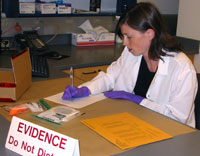
|
|
In her role as evidence analyst, Angi Christensen examines evidence in an area of restricted access.
|
My typical workday is interesting because I perform two distinct jobs: 1) working as an Evidence Analyst, and 2) working as an Evidence Technician. Both jobs involve lab work and administrative work. My schedule is routine. I work 7:00am - 3:30pm Monday through Friday.
Working as an Evidence Analyst
Half of my workday, I am an Evidence Analyst in the Evidence Control Unit. This is where I inventory incoming evidence and prepare it for examination in case-working units. It is very interesting work because I am involved with evidentiary items including bones, firearms, DNA, hair, and fingerprints. I have learned a lot about the many types of forensic examinations and how the laboratory operates.
Working as an Evidence Technician
The other half of my workday, I am an Evidence Technician in the Trace Evidence Unit. This is where I process items of evidence for hairs, fibers and other types of trace evidence, and assist with anthropological examinations. Usually, this involves removing hairs and fibers from items of evidence and preparing them on microscopic slides. They will be studied and compared under a microscope by a forensic examiner. Anthropological exams may involve determining if bone is human, repairing skulls for facial reconstruction, making a personal identification, or analysis of trauma.
My Other Roles
- Instructor - On occasion, I have worked as an Instructor at the FBI's Evidence Response Team school.
- Forensic Anthropologist - I also work as a Forensic Anthropologist with the Disaster Mortuary Operational Response Team (DMORT), which is part of the Federal Emergency Management Agency and the U.S. Department of Homeland Security. In this role, I am on-call to respond to mass disasters by assisting with the recovery and identification of human remains.
|
|
3. What I like best/least about my work...
|
Back to Top

|
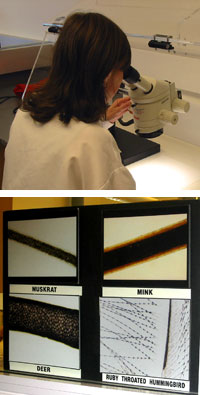
|
|
Angi Christensen examines a hair sample under the microscope (top), a typical task in her lab work as an evidence technician. Micrographs of animal hairs show structural details specific to a species or an individual (bottom).
|
What I like best about my work is that almost every day is different and rewarding. Every case is unique and presents new challenges, which keeps me thinking and stimulated. The idea that everything I do is helping to solve a crime and/or provide closure for loved ones is very rewarding. I am almost always busy, which is something I like. I also really enjoy the social environment of my workplace. I work with a group of talented, resourceful and fun-loving people. We socialize often, both at and outside of work. Because I enjoy my job and co-workers so much, I never want to miss a day of work.
What I like least about my work is the paperwork of course. However, it is a critical part of the job and important to accomplishing my goals and the goals of the laboratory. Occasionally, everyone is asked to help with other duties like gathering trash or cleaning the lab space. This is easy work and generally does not take much time. Some challenges of my job involve change. When special paperwork or approvals are needed things can move very slowly requiring some patience.
|
|
4. My career goals are...
|
Back to Top

|
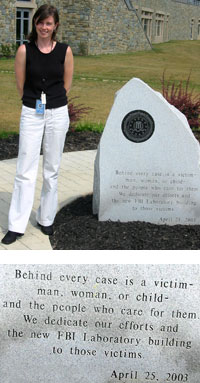
|
|
Angi Christensen shares the goal to work for victims, as inscribed on the laboratory building's dediction plaque (top) inset (bottom).
|
My career goal is to become a Forensic Examiner performing forensic anthropological examinations and testifying in court as an expert witness. I would also like to become a board-certified Forensic Anthropologist by taking and passing the qualifying examinations with the American Board of Forensic Anthropology. I hope to accomplish both of these goals within the next 5 years, which will create changes in my day-to-day duties and schedule.
|
|
5. When I'm not working, I like to...
|
Back to Top

|
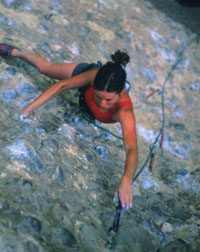
|
|
Angi Christensen scales a nearly vertical rock, an activity she enjoys on weekends.
|
When I’m not working, I like to go rock climbing, which I do almost every weekend. It is a great physical and mental challenge. Escaping into the woods and rocky cliffs is a great get-away from the laboratory and day-to-day life. It's also a great way to spend quality time with friends. I am an avid reader (John Steinbeck is my favorite author). I also enjoy doing crafts including knitting.
|
|
6. It's never too late to change you career path...
|
Back to Top

|
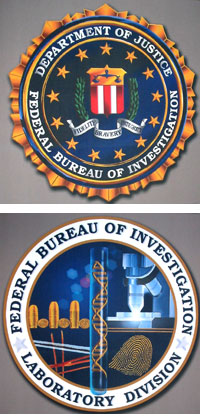
|
|
| |
FBI agency insignia (top) FBI laboratory insignia (bottom).
|
Don't feel pressured to decide your career path before you start college. It's never too late to change your mind. Don't be afraid to do so if you think you might be happier. Even if you really are passionate about a particular area, some diversification will make you more flexible and marketable.
|
|
|
|
 |